Welcome to Matrix Education
To ensure we are showing you the most relevant content, please select your location below.
Select a year to see courses
Learn online or on-campus during the term or school holidays
Learn online or on-campus during the term or school holidays
Learn online or on-campus during the term or school holidays
Learn online or on-campus during the term or school holidays
Learn online or on-campus during the term or school holidays
Learn online or on-campus during the term or school holidays
Learn online or on-campus during the term or school holidays
Get HSC Trial exam ready in just a week
Get HSC exam ready in just a week
Select a year to see available courses
Science guides to help you get ahead
Science guides to help you get ahead
In this article, Physics Teacher DJ Kim gives you the insights to the syllabus Band Descriptors that you need to ace Physics for the HSC.

Join 75,893 students who already have a head start.
"*" indicates required fields
You might also like
Related courses

Join 8000+ students each term who already have a head start on their school academic journey.
Are you prepared for your upcoming Physics Trial exams? Do you feel like you have an in-depth knowledge and understanding of the key concepts in Physics Modules and Option topics?
If not, don’t worry! we’ve put together the ultimate guide to acing your Physics Trial exam! In this post, leading Matrix Physics teacher, DJ Kim shares his secrets for acing your Physics exams.
Here’s a quick and easy action you can take.
Get the competitive edge for your next Physics assessment! Fill out your details below to get this resource emailed to you. "*" indicates required fields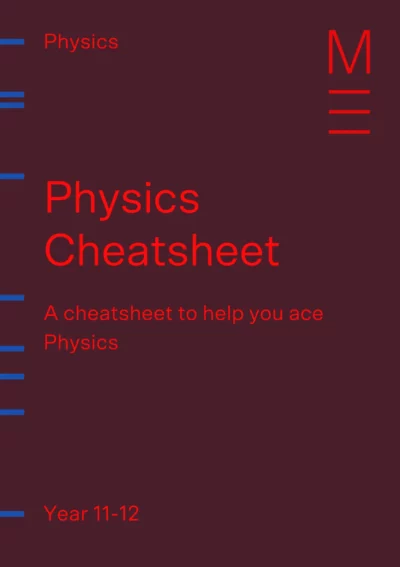
Download your FREE foldable Physics Cheatsheet

Download your FREE foldable Physics Cheatsheet
In order to ace any exam, you’ll need to have a clear understanding of what’s expected of you. Only then, you can develop a plan for meeting those expectations.
In this article, I have shared my understanding of your expectations in the HSC Physics exam from NESA (Yep, the people who make your exam!) as well as how to meet those expectations with actionable academic advice.
After reading this article, you’ll realise that this applies to any of your Physics school exams as they are geared towards preparing you for the HSC exam.
Let’s start by analysing HSC Physics Band 6 Performance Descriptors from NESA so that you can understand clearly what’s expected of you in HSC Physics course.
How can you find out what’s expected of you in the Physics exam? Reading Band 6 Performance descriptions from NESA Website will give you an insight of what’s expected of you in your exams including both Trial and HSC Physics exams.
Once you know what is expected of you, then it is easier to work towards meeting that expectation.
If we look at the Performance Band 6 Descriptors, we can draw the following conclusions. In order to receive Band 6 in Physics, you must:
If I was to summarise the HSC Physics course in one word, it would be ‘understanding’.
If you want to ace your Physics exams, then you really have to know your stuff. The HSC Exam Committee says you must demonstrate an extensive knowledge and understanding of the concepts if you want to score an HSC mark of 90 or above (Band 6).
How do you know that you have gained extensive knowledge and understanding? If you can explain the difficult and complex concepts to your friend clearly and he/she can understand it, then you are considered to have an extensive knowledge and understanding.
To do this, when you are studying you want to know each of the syllabus dot-points for each of the core topics and your option topics.
But more importantly, you need to be able to apply it confidently and this means practice and revision.
To get a sense of why this is important, let’s look at some of the 2017 HSC Exam Questions that require students to demonstrate an in-depth knowledge and understanding in order to solve them.
2017 HSC Question 24 (b)
Using the law of conservation of energy, show that the escape velocity of an object is independent of its mass.
2017 HSC Q24b requires students to derive the escape velocity using the law of conservation of energy. Students with sound knowledge and understanding may be able to recall the escape velocity formula but not able to derive it.
2017 HSC Question 26 (b)
When the 100-tonne space shuttle re-entered Earth’s atmosphere from its orbit, the gases compressed in front of the decelerating shuttle reached a temperature of 5000K.
The graph shows the intensity of radiation emitted by gases at 5000 K.
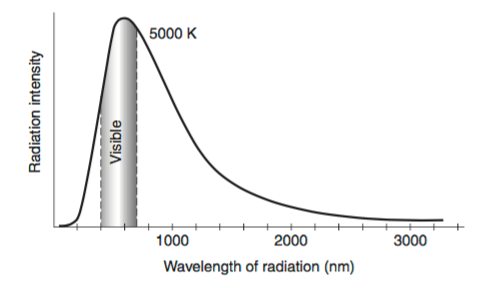
2017 HSC Q26b requires students to apply their understanding of concepts from ‘Space’ and ‘From Ideas to Implementation’ modules to be able to answer the question.
Students must remember that your trial and HSC exams will ask questions that integrate many aspects of the syllabus within and from the different module(s).
Here are 3 of my secrets for what you should (and shouldn’t) do to gain extensive knowledge and understanding of Physics.
Being able to answer the syllabus dot points will only equip students with sound (not extensive) knowledge and understanding and thereby meeting Band 4 Performance Criteria. Studying for answers to the syllabus dot points is clearly inadequate and dangerous as it gives students an illusion of having gained an extensive knowledge and understanding of the key concepts.
Instead, you need to strive towards gaining a detailed and in-depth knowledge and understanding.
If you don’t understand a physics concept, don’t try to memorise it. There are two main reasons:
Instead, find alternative sources of information. Ask your school teacher to explain the concepts multiple times till you have the ‘aha’ moment.
Teachers at Matrix strive towards providing students with clear explanations using creative teaching methods and tools such as simulations, diagrams, flowcharts and various types of analogies.
As I said above, you need more than one source of information. You will find that a textbook is not sufficient in helping you gain an extensive knowledge and understanding of the concepts of the physics course. You will need to seek additional resources online (for example, YouTube videos and Wikipedia articles) or even borrow university textbooks to gain a detailed and extensive knowledge.
When I was studying for Physics, I remember having to rely on many different textbooks to get a clear understanding of the key concepts. Some textbooks were just better at explaining certain concepts better than others. But I wish I had the extensive online resources that you have!
How pn junction works in solar cells is a great example of a concept that students struggle with because textbooks simply don’t explain it clearly using band structure.
The diagrams below from our Physics Theorybook illustrate the process of how it works.
Diagram 1: Band Structure of pn junction
Diagram 2: Diffusion
Diagram 3: Formation of depletion layer and electric field
Diagram 4: One-to-one interaction between an electron and a photon
Diagram 5: Voltage across the solar cell and hence current flow
At Matrix, students are provided with a detailed and comprehensive theory and workbooks that are aimed at helping students gain a detailed and extensive knowledge. Take a sneak peek at one of our resources!
Put your knowledge to the test with our Year 11 Physics yearly exam paper. Fill out your details below to get this resource emailed to you. "*" indicates required fields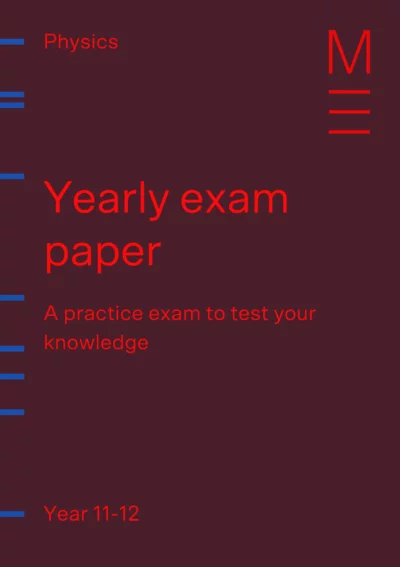
Get ready for your Yearly Physics Exam

Get ready for your Yearly Physics Exam
This descriptor requires you to be able to communicate your knowledge. This builds upon the first descriptor – you can’t address this point without first acquiring the knowledge to demonstrate.
To be able to explain physics concepts clearly, students require the following:
We have already discussed how you could gain an extensive knowledge and understanding of concepts.
If you’re struggling with your Physics marks, you’d better get on top of things before Entropy really kicks in.
Physics doesn't need to be confusing
Expert teachers, detailed feedback, one-to-one help! Learn from home with Matrix+ Online Courses.
Now, let’s explore a powerful tool – flowcharts – that can help you with an outstanding ability to describe and explain clearly and accurately.
Why use a flowchart?
If you can distil your understanding of concepts in the form of simple mindmaps or flowcharts, then you really know your stuff.
Using flowcharts forces you to break concepts down into processes and procedural chunks. You need to think about order of operations, but also how to visual that.
Conceptualising things visually requires you to think about the order of information and ideas involved, but also how to communicate that effectively and efficiently. Like I said, this is a true test of your knowledge.
Below are examples of some flowcharts that I use with my students at Matrix when showing them this learning process.
Acceleration and Force:
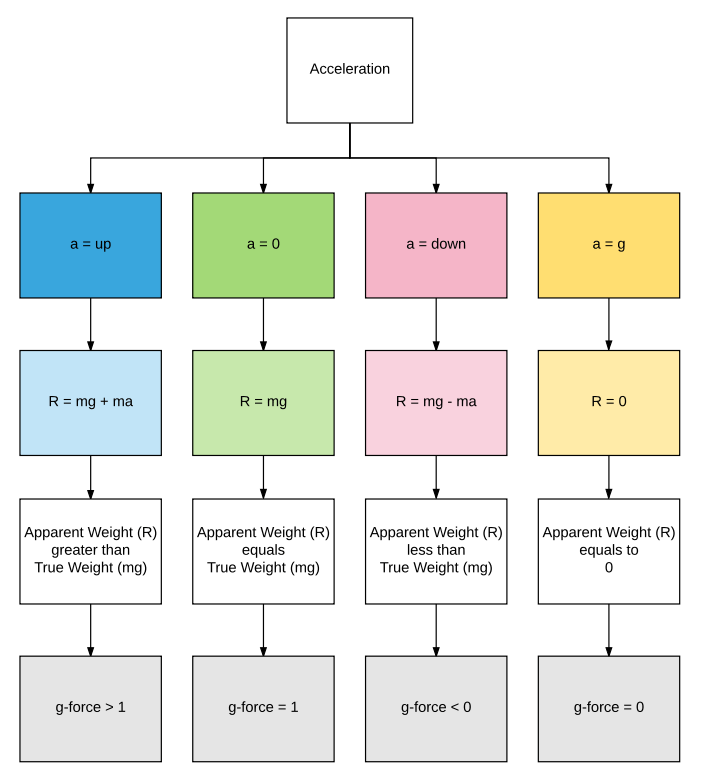
Operation of Induction Motors:
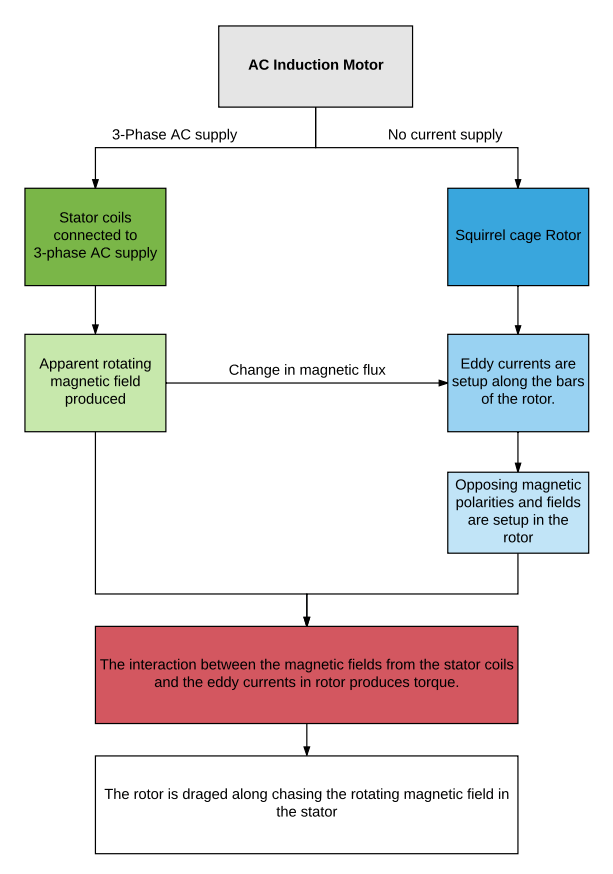
A breakdown of Hertz’s experiment:
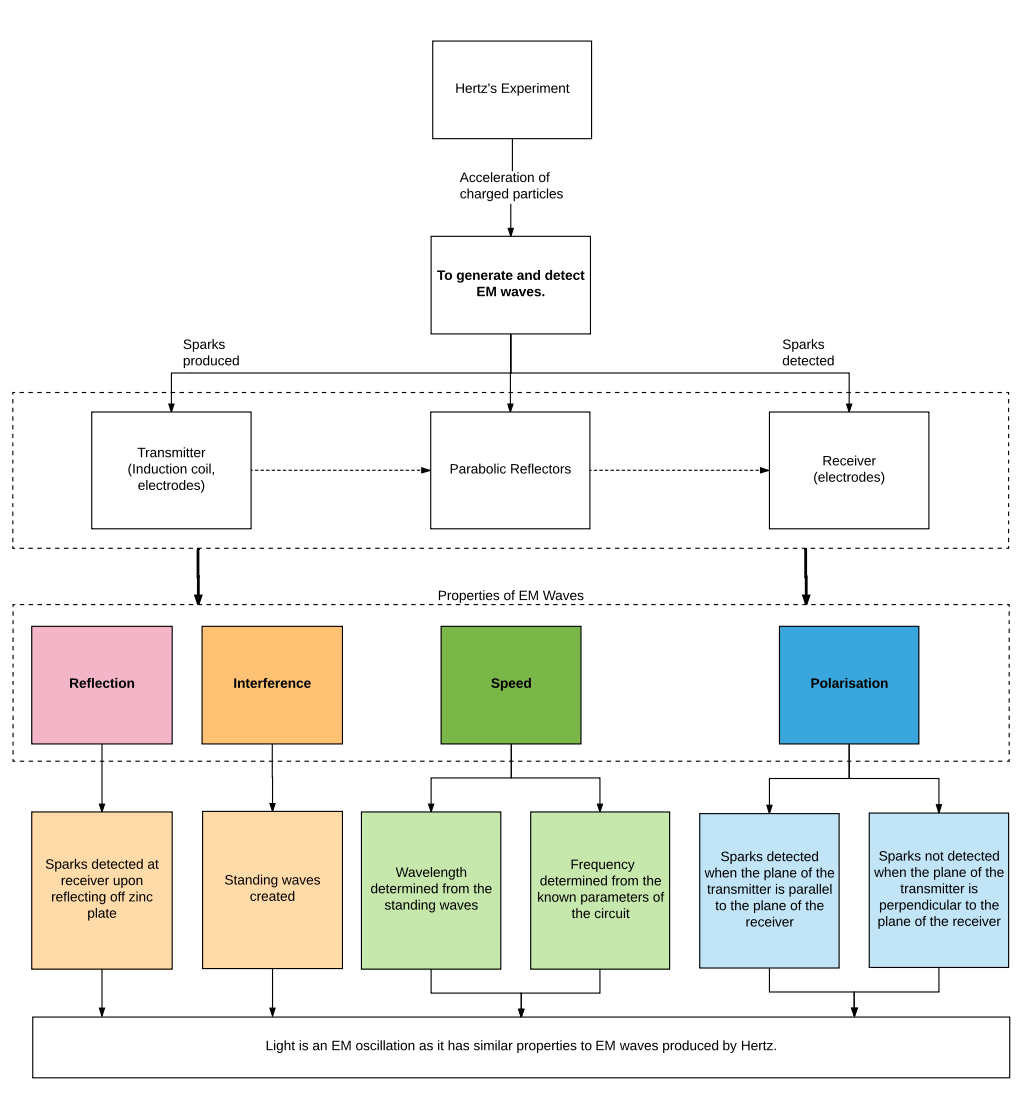
Answering single-step questions doesn’t require you to think on your feet to the degree that more complex questions do. If you have a single-step question, you are applying a single concept in one step. This descriptor requires you to draw on your extensive knowledge AND your critical thinking skills to apply various concepts in the one question.
This is difficult and again requires you to have extensive knowledge of your topics.
A good example of why this is are ‘calculate’ HSC exam questions.
Any ‘calculate’ HSC exam questions worth 2 marks are considered simple calculation questions as they do not require multi-steps to solve. However, there are calculation questions worth 3 or 4 marks in HSC Exams.
These questions are considered more challenging as they involve multi-steps and requires students to apply high-level critical thinking skills to solve.
Let’s look at a 3 mark HSC Exam question.
2017 HSC Q23(b)
The diagram shows electrons travelling in a vacuum at 5.2 × 104 ms–1 entering an electric field of 10 Vm–1
A magnetic field is applied so that the electrons continue undeflected. What is the magnitude and direction of the magnetic field? 3 marks
To solve this question, students need to know how to balance electric AND magnetic forces which involves applying the direction of magnetic field in a different plane to electric field.
As you can see, students without a detailed knowledge and understanding of electric and magnetic fields and forces will not be able to apply their critical thinking skills to figure out the magnitude and direction of the magnetic field.
Physics questions often require you to demonstrate your Physics skills. What are the Physics skills?
A good example of demonstrating competent physics skills is how you approach second-hand investigations.
The physics skills relating to second-hand investigation questions are outlined below.
HSC Physics Skills Outcomes12.4 process information to:a) assess the accuracy of any measurements and calculations and the relative importance of the data and information gathered b) identify and apply appropriate mathematical formulae and concepts c) best illustrate trends and patterns by selecting and using appropriate methods, including computer-assistedd analysis d) evaluate the validity of first-hand and secondary information and data in relation to the area of investigation e) assess the reliability of first-hand and secondary information and data by considering information from various sources 13.1 present information by:f) selecting and drawing appropriate graphs to convey information and relationships clearly and accurately g) identifying situations where use of a curve of best fit is appropriate to present graphical information |
Let’s use a flowchart to break this down. Physics skills can be categorised as:
There will always be questions that assess your Physics skills in your Trial and HSC exams.
Let’s look at some examples.
2012 HSC Q21 shown below assesses you on your understanding of the accuracy and the reliability data collected:
2012 HSC Q21
2004 HSC Q26 shown below assesses you on your ability to analyse the second-hand data provided to find an unknown constant.
2004 HSC Q26
The diagram shows part of an experiment designed to measure the force between two parallel current-carrying conductors.
| I2(A) | FORCE (X10-6N) |
| 0 | 0 |
| 2.0 | 7 |
| 3.0 | 11 |
| 4.0 | 14 |
| 5.0 | 18 |
(a) Plot the line of best fit. 3
(b) Calculate the gradient of the line of best fit from the graph. 1 Mark
(c) Write an expression for the magnetic force constant k in terms of the gradient and other variables. 2 Marks
(d) Use this expression and the gradient calculated in part (b) to determine the value of the magnetic force constant k. 1 Mark
Let’s see how we can prepare for these types of exam questions.
Reliability, accuracy, and validity are related but essentially different concepts. To apply and test for them you must be intimate with their definitions. Let’s recap them:
| Definition | How to improve | |
| Validity | The experimental method and how appropriate it is in addressing the aim of the experiment | Keep control variables constant so that dependent variable is only related to the independent variable |
| Reliability | How close repeated measurements are to each other. | Reduce random error by removing parallax error and ensuring the environmental factors are kept constant. |
| Accuracy | How close the final result is to the correct or accepted value | Reduce systematic error by calibrating equipment |
We draw graphs to make it easy to identify trends in data that we have collected. As such it is an important Physics skill.
However, I am surprised by how many Year 12 Physics students are unable to draw the line of best fit correctly every year.
See examples of common mistakes others have made in the past.
1. Do not fit the line to obvious outliers. The line of best fit drawn below is incorrect as it does not remove an obvious outlier from its trend.
2. The line does not have to go through any particular data point or through the origin. The line of best fit drawn below is incorrect as it is fit to pass through the origin.
3. The correct line of best fit is drawn below. It is correct as it ignores the outliers and ensures there are about the same number of data points on either side of the line at each end (the line should be balanced in the middle of the data).
Are you confident with your graphing skills now? If you’re not 100% confident about how to draw a scientific graph correctly, read our blog: How to Draw a Scientific Graph Correctly.
In almost all questions involving second-hand investigations, you will be asked to draw a line of best fit rather than a curve of best fit.
Remember, the line of best fit will obey the following mathematical relationship:
y = mx + b
But it is sometimes more useful to express this in terms of variables of the experiment as shown below:
Dependent variable = (control variables) x independent variable + b
Hence, the gradient of the line of best fit represents the control variables of the experiment.
Gradient = control variables
As you can see, applying y = mx allows us to visualise practical physics skills!
Exams require you to communicate quickly and concisely. You have to have clear responses that don’t waffle, but also present ideas in a logical manner that is sequential.
To make your life easier, NESA uses specific terms that instruct you on how to communicate. Students are required to respond to key verbs such as ‘describe’, ‘explain’, ‘compare’ and ‘assess’ appropriately using the appropriate scientific communication structure and format.
So, if you want to do this effectively, you will first need to:
| Verb | Definition |
| Explain | Relate the cause and effect; make the relationships between things evident; provide why and/or how |
| Describe | Provide characteristics and features |
| Assess | Make a judgement about the value of |
You can see the complete Glossary of HSC Key Words in this post.
To better understand this, let’s use the verb ‘explain’ as an example.
‘Explain’ is a common key verb used for 2- 4 mark exam questions. The mark allocations for the key verb ‘explain’ in Part B of the HSC Physics Exam papers are listed below:
As ‘explain’ verb is the most heavily mark allocated verb in the HSC exam paper, let’s explore a step-by-step process for how to answer ‘Explain’ HSC Physics questions.
To answer ‘Explain’ questions, adopt the following structure:
Explain links a start point to a conclusion using a law of physics as and needs a sequential flow of logic and from start point to finish point.
Let’s answer an explain question using the structure outlined above.
2014 HSC Q25b
Explain how the motor effect is used in an AC motor.
Answer:
Step 1: identify the start and finish point.
Step 2: Use a relevant law of Physics to provide physical reasoning.
If you need to know more about answering ‘Explain’ questions, read our post here.
You have to be able to describe certain investigations. But these are things you can revise and practise well before your trials. Fortunately, NESA lists what these are.
Make sure you know how to describe the following mandatory first-hand investigation:
All of the actionable advice in the world won’t be effective unless you practise applying it. The best way to assess your depth of knowledge, understanding, and skills is to do past Trial and HSC exam papers (past papers can be found here on the NESA website). You should do at least 5, preferably 10 past papers before the exam.
In case you don’t do very well in your trial exam, please don’t stress over it. The HSC exam mark has a greater impact on your overall HSC mark, more than 50% if you take into the moderation of your overall assessment mark. And so you can make up for the poor result by working hard rather than getting stressed.
Written by DJ Kim
DJ is the founder of Matrix Education and has over 20 years of HSC Physics teaching experience. He is the co-author of the Matrix Science program, course materials and assessments. He is also renowned for his ATAR & Scaling seminars and development of the first ATAR Calculator.© Matrix Education and www.matrix.edu.au, 2025. Unauthorised use and/or duplication of this material without express and written permission from this site’s author and/or owner is strictly prohibited. Excerpts and links may be used, provided that full and clear credit is given to Matrix Education and www.matrix.edu.au with appropriate and specific direction to the original content.